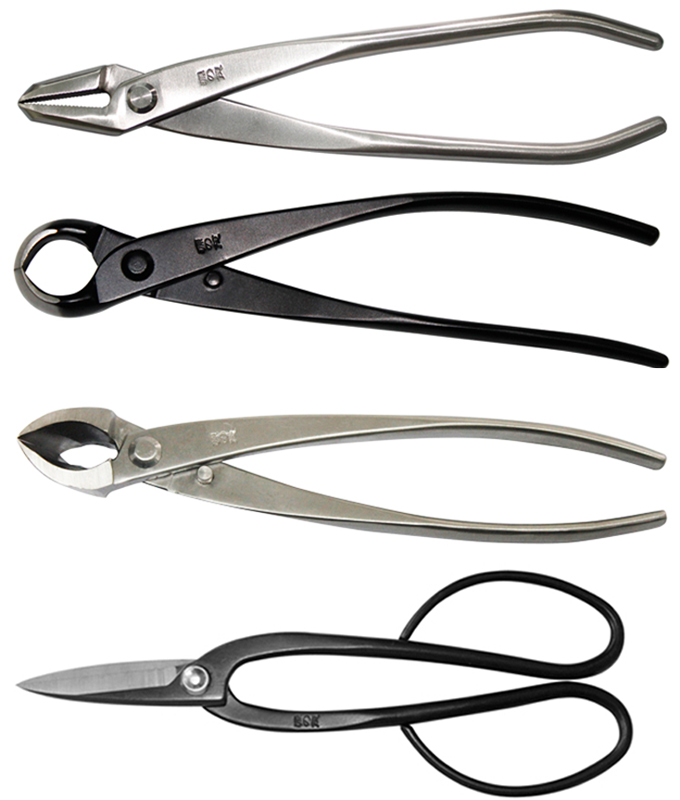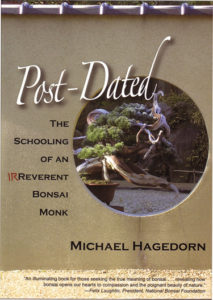Magnificent Monster
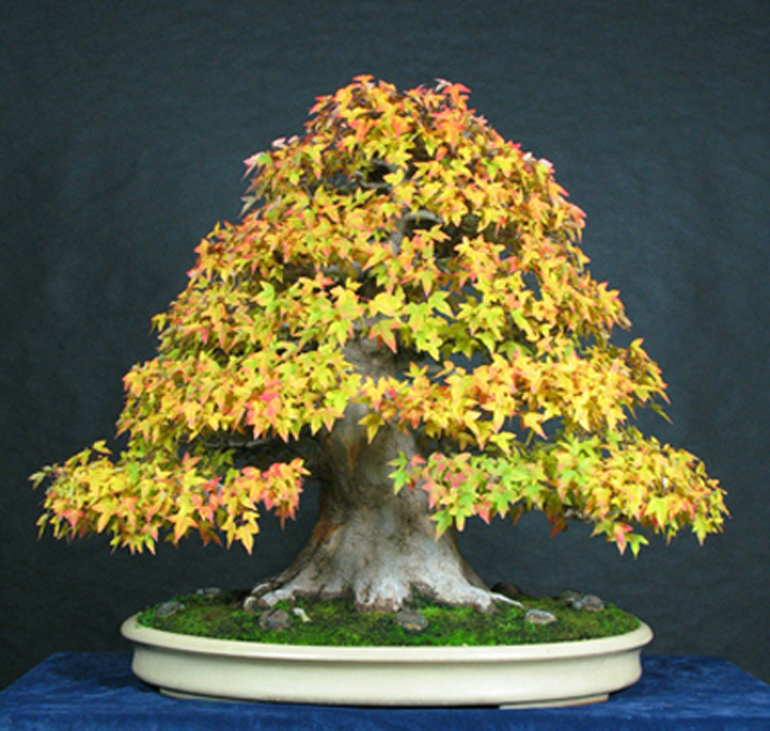
In addition to its brilliant color, this powerful Trident maple has almost everything you'd want in a bonsai, including a massive trunk, fluid natural looking nebari, good lines, a well-matched pot and healthy green moss. The artist is German Gomez.
Continuing with our Maple theme…
Leaving for vacation in two days and still have a million things to do, so to save some time we’ll go back in time. The photos shown here first appeared on Bark way back in 2010.
–

I think this photo was shot in the spring. The traces of color are leaves that are slow to turn from their fresh spring red to summer green.
More Magnificent Maples
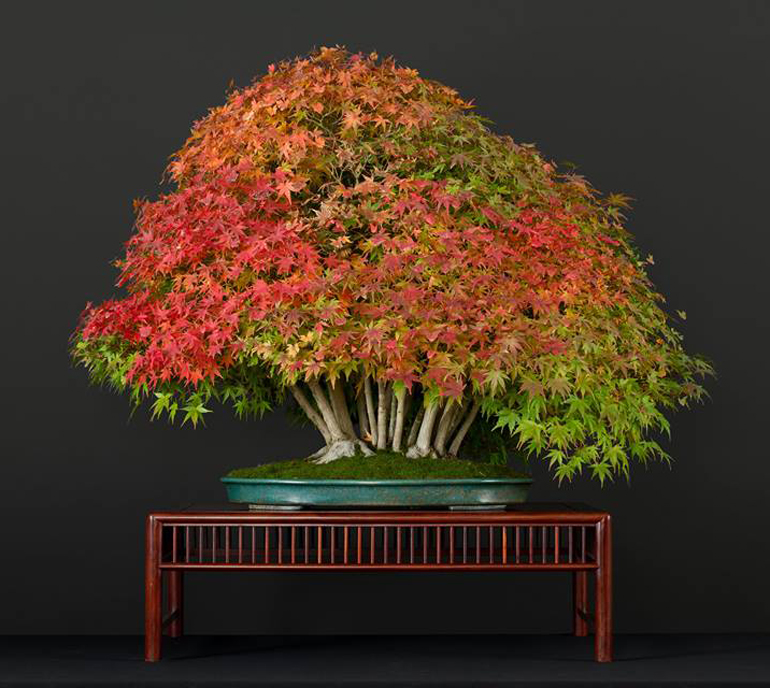
Luis Vallejo calls this Yama momji Japanese maple. Yama is mountain and momiji is Japanese maple (Acer palmatum). So you'll sometimes hear this variety referred to as Mountain maple, which is the original, naturally occurring, non-cultivar Japanese maples. Because of the differences in the leaves, I'm guessing that this was originally several different trees that were planted very close together, rather than a clump style planting.
Yesterday we featured three magnificent maples that belong to Luis Vallejo. Turns out they are just the tip of his maple offering. Here’s a few more for your enjoyment. If you’re inclined, there are still more on Luis’s timeline
–
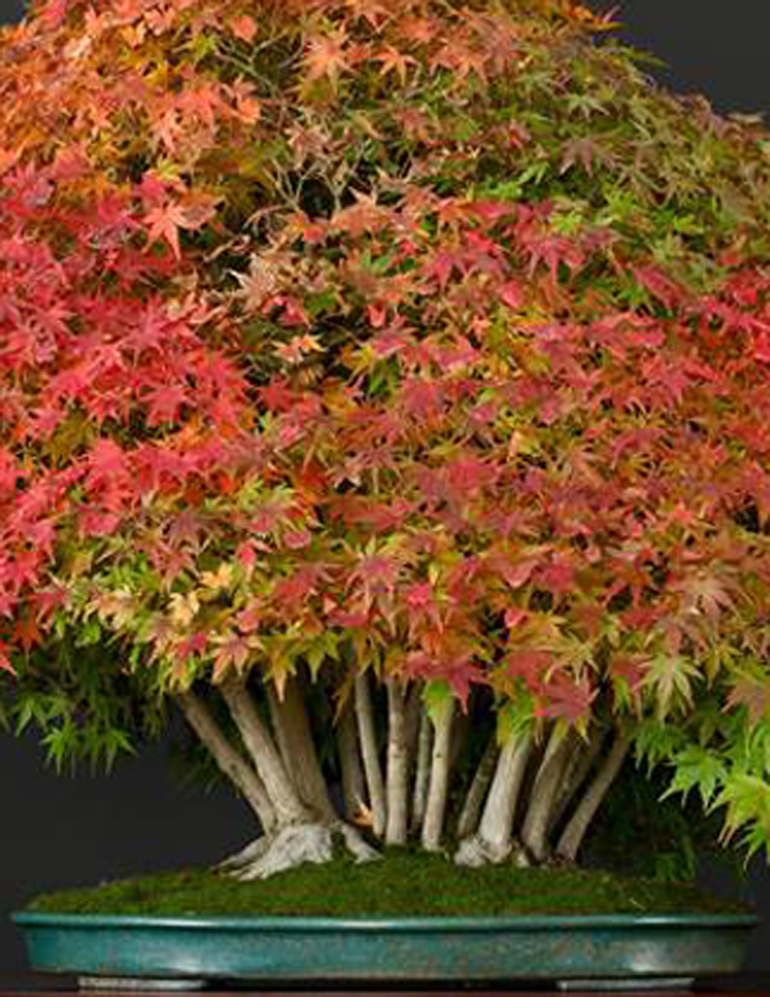
Closeup. Some of the trunks have fused. Perhaps the three that have fused (on the left) is one tree with three trunks.
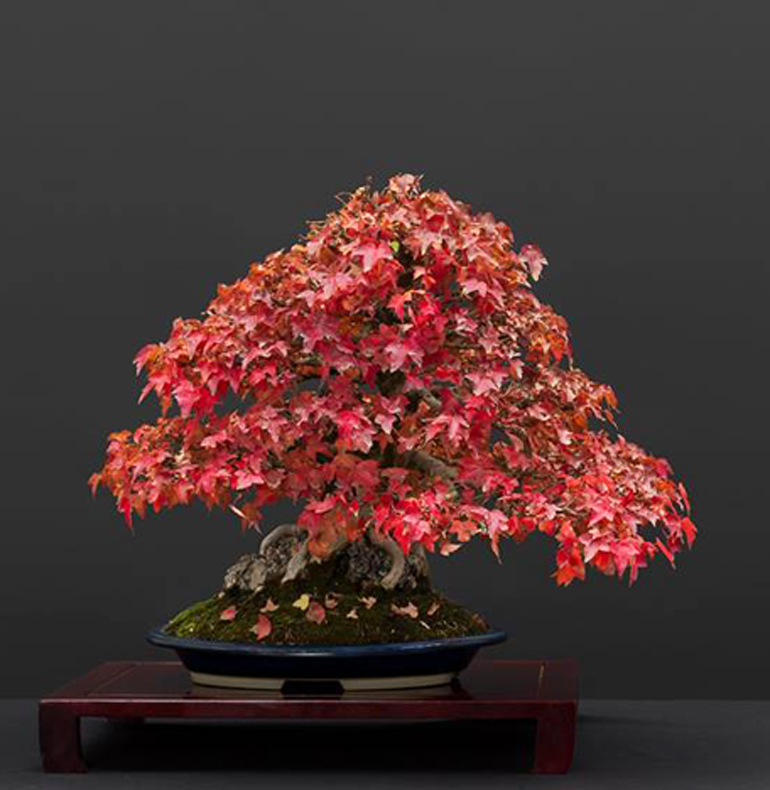
Root-over-rock Trident maple (Acer buergerianum). The Japanese name is Kaede
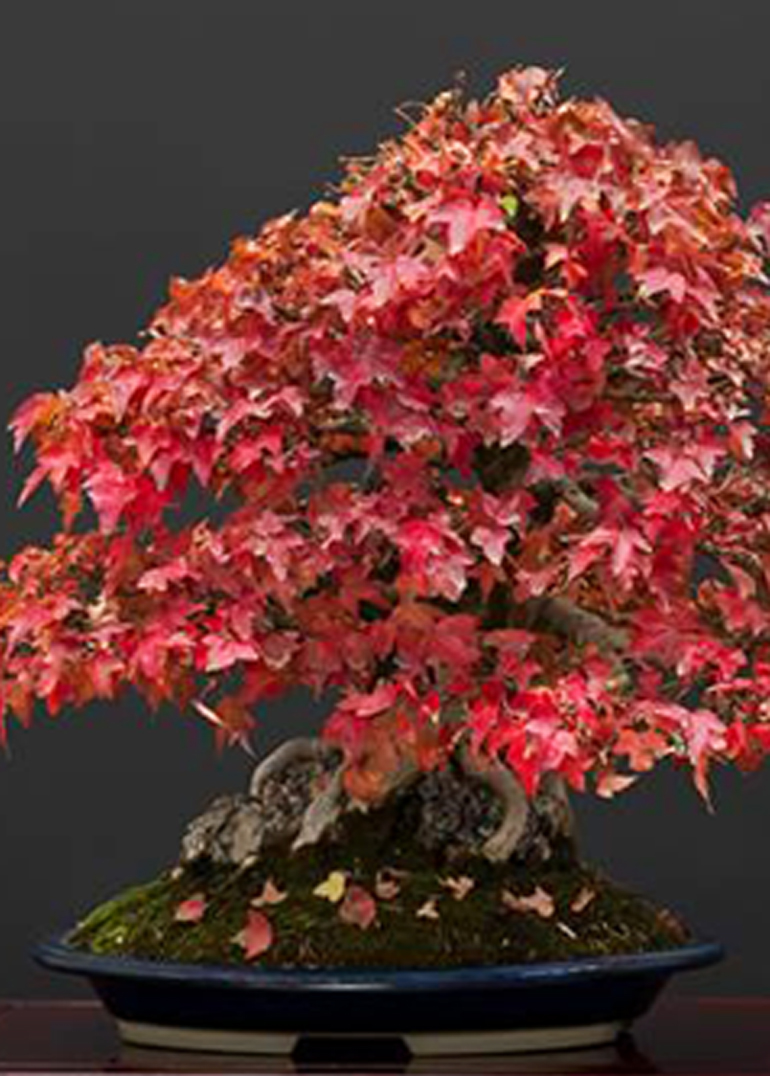
It's a little easier to see the rock in this closeup.
Another Trident maple. It's unusual to have a completely hidden trunk, but occasionally you'll see trees that are styled almost exclusively to show off their impressive crown of leaves. Like this one
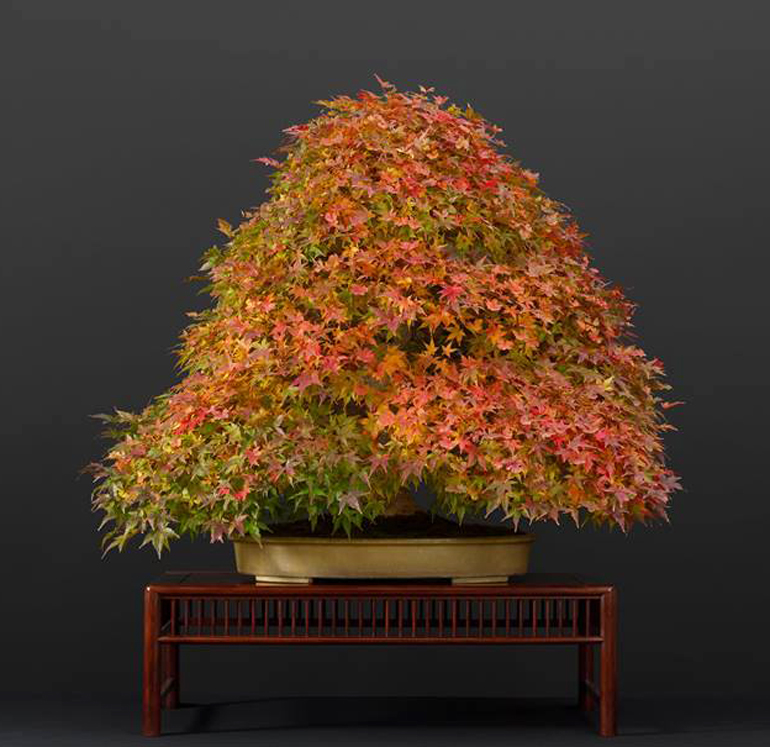
Another tree designed to show of its colorful leaves at the expense of the trunk. Luis calls this one an Acer Palmatum Benichidori.
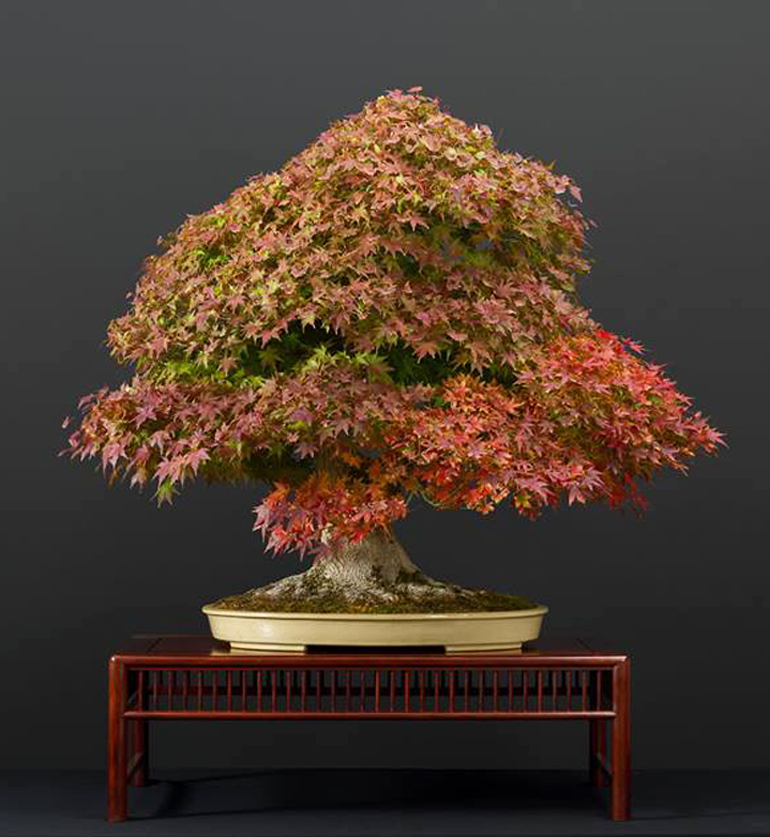
Another Yama momoji Japanese maple and another impressive crown of leaves. But this time you can see the trunk's powerful base and nebari
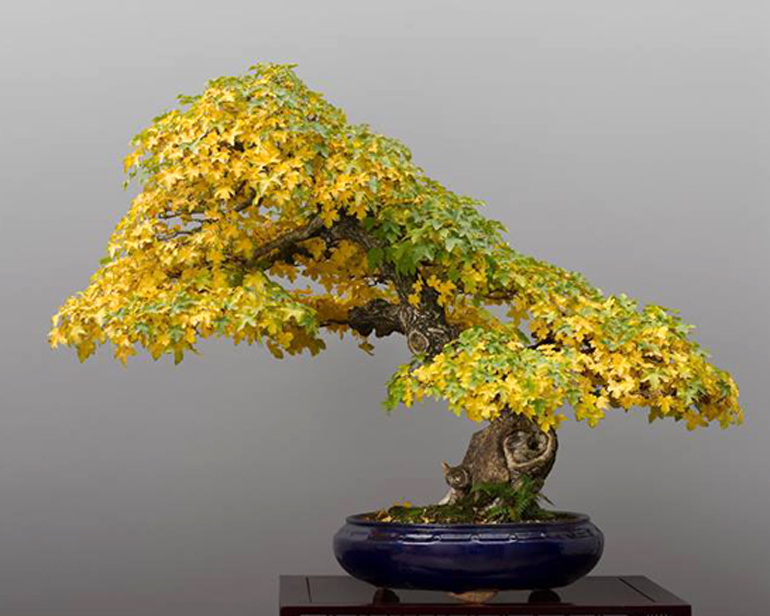
Hedge maple (Acer campestre). A little change of pace... it's still a maple, but a much less common maple (in bonsai circles at least).
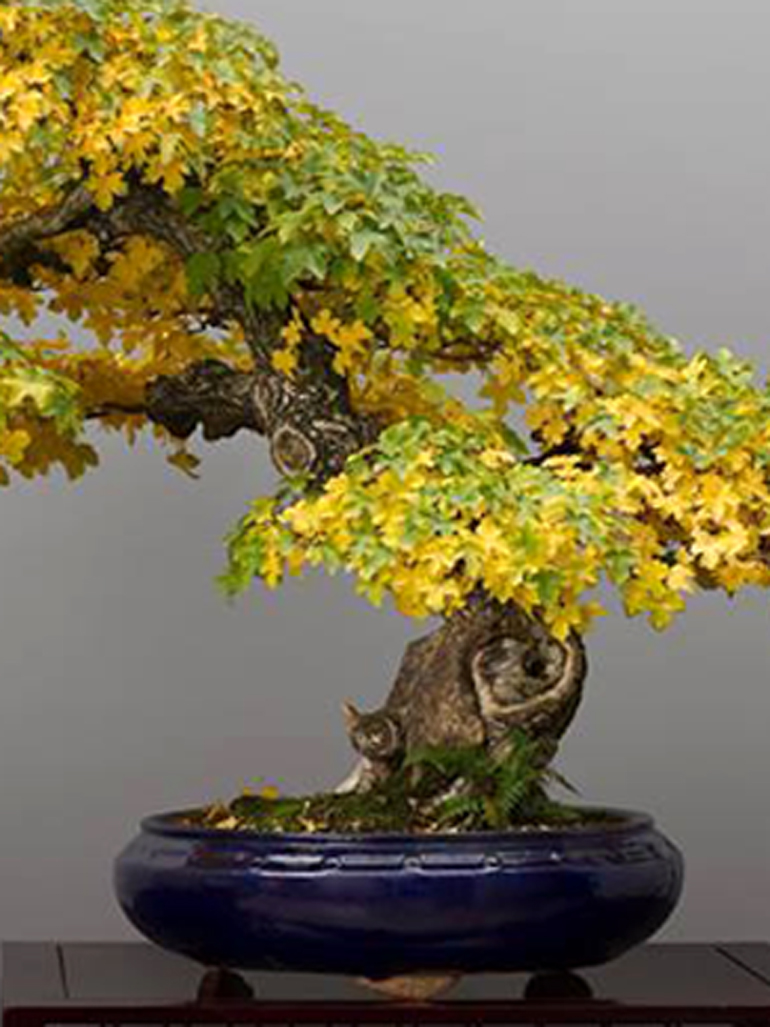
Now you can see the fern...
Three Magnificent Maples
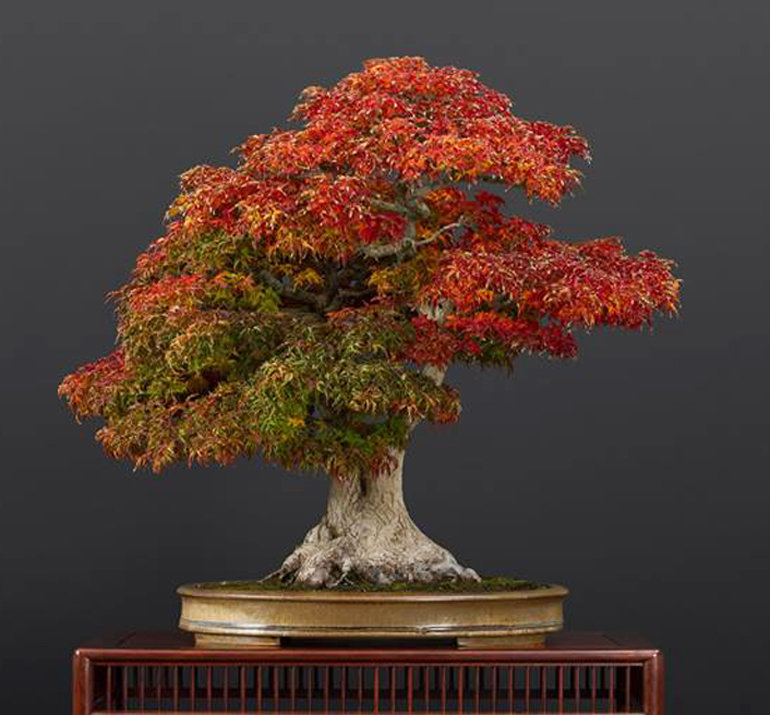
This multi-hued beauty is from Luis Vallejo's Museo de Bonsai in Alcobendas Spain (near Madrid). It's hard to distinguish individual leaves (I need new glasses!) but they look like they might be Trident maple.
Today we’ve got three magnificent maples, each with leaves ablaze. Even without their fiery leaves all three would be brilliant bonsai. With them, well… you can see for yourself. They’re from Luis Vallejo’s facebook timeline. If you’ve got a moment, there’s plenty more where these came from.
Visit Stone Lantern for the
BEST PRICES ON BONSAI WIRE
–

Here's a closer look at those suspiciously Trident looking leaves. Good look at the base of the trunk and pot as well
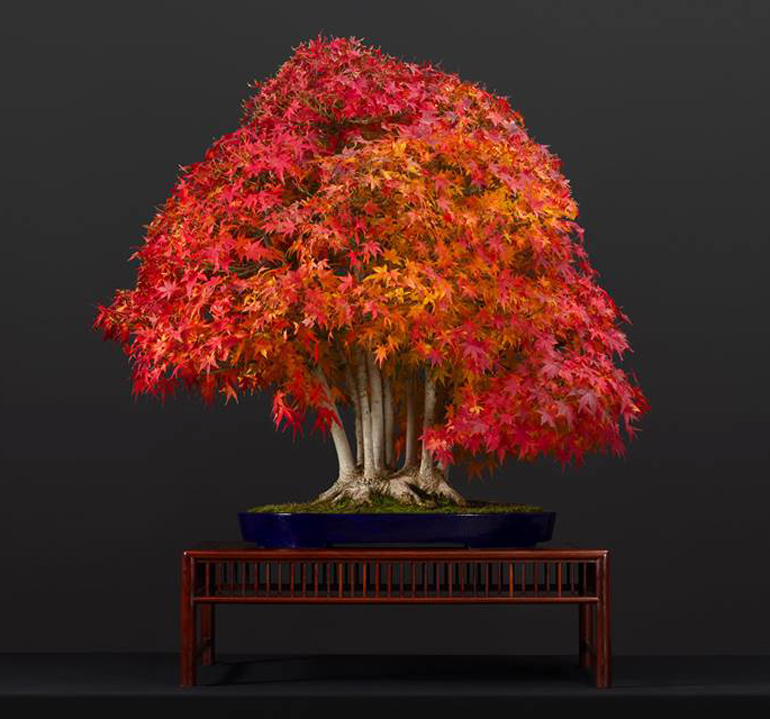
And you thought the tree above is colorful

Fiery Japanese maple leaves. Nice nebari too
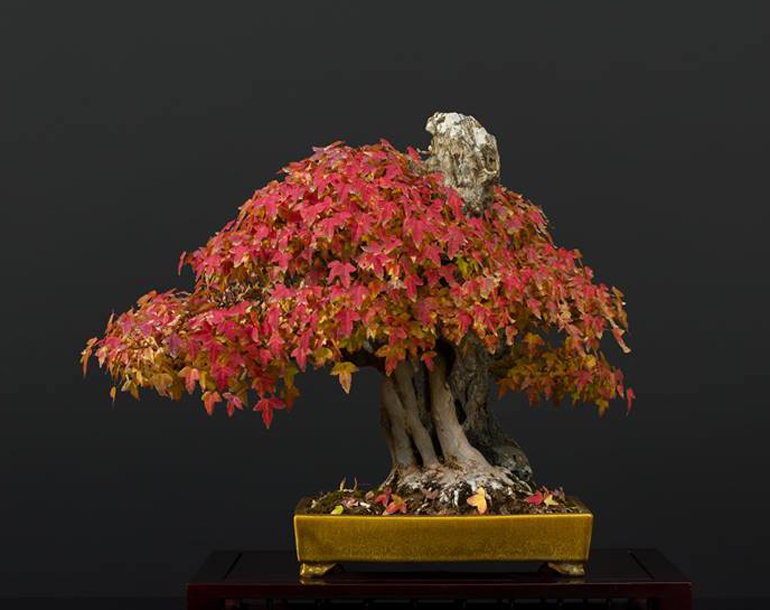
You're probably a little jaded by now with all the color, but if you can forget the two above for a moment, this one is no slouch
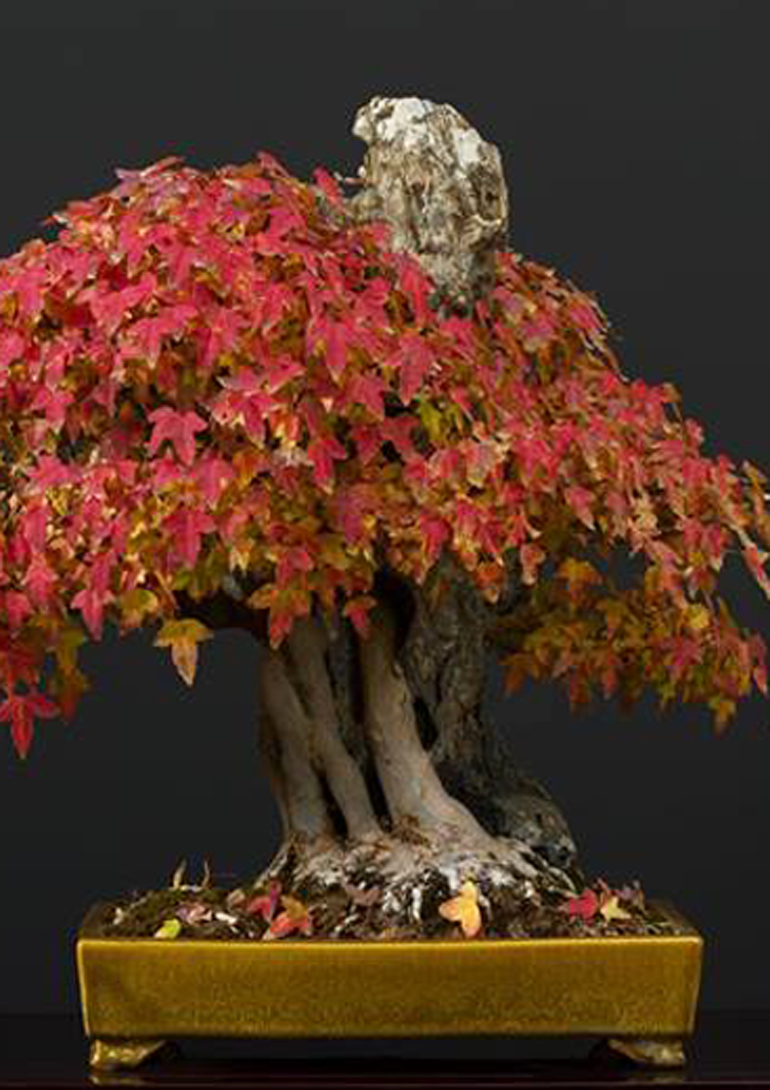
Looks like a root-over-rock (partial root-over-rock?), where the tree is fused to the rock. This is common with Trident maples
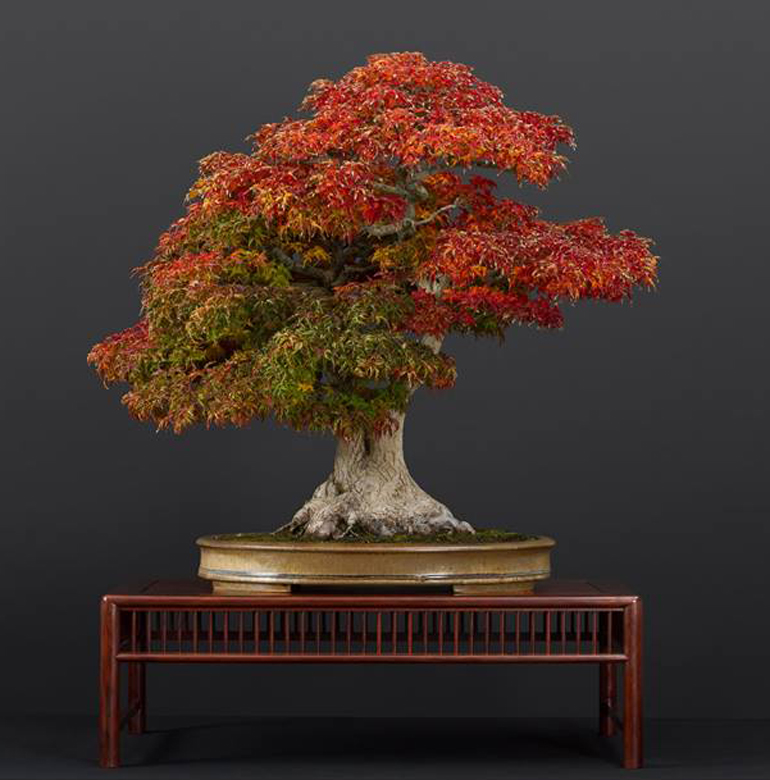
The original photo of the tree at the top of post. With the whole stand, including the leg.
When Was the Last Time You Climbed a Bonsai Tree?
It's not that often you see a full grown man sitting in a bonsai tree (why doesn't the tree fall over?). The caption and the photo are from BCI magazine.
Yesterday we featured a major league rock planting by Simon Baron with Marc Noelanders. Simon is a new talent to us, but most of you know Marc, a respected and accomplished bonsai artist, teacher and author. Marc is also the founder and ongoing force behind the annual Noelanders Trophy Bonsai Exhibition. This post originally appeared here in December, 2015. It features the only photo I know of with a human sitting in a bonsai.
–
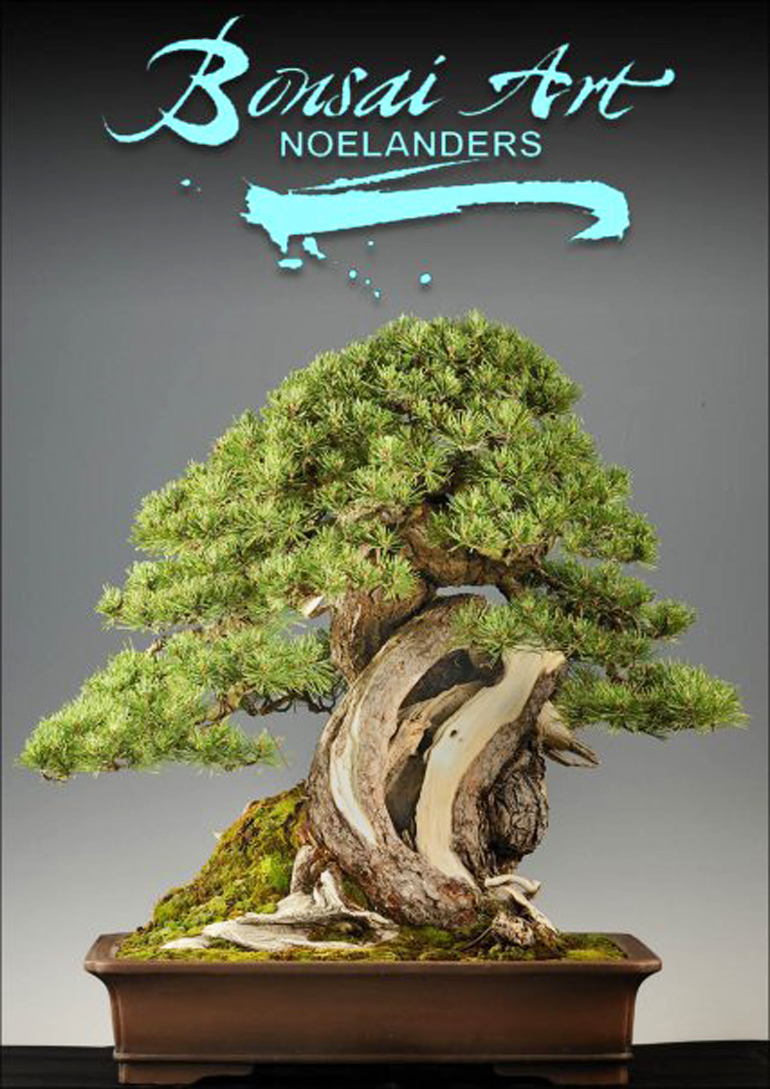
Though the tree at the top of the post (with and without Marc) is the real show stopper, this one isn't half bad either. It's the tree that appears on the cover of the 10th Noelanders Trophy book. I couldn't find any information on the variety, the artist or the photographer, but it looks like it might be a Japanese white pine.
This photo is from Bonsai Focus. Here's their caption: "One of the best shows in Europe, The Noelanders Trophy, initiated by Marc Noelanders. Held every year in January, Heusden Zolder Belgium . Photo's: Willy Evenepoel."
The Sky Is the Limit
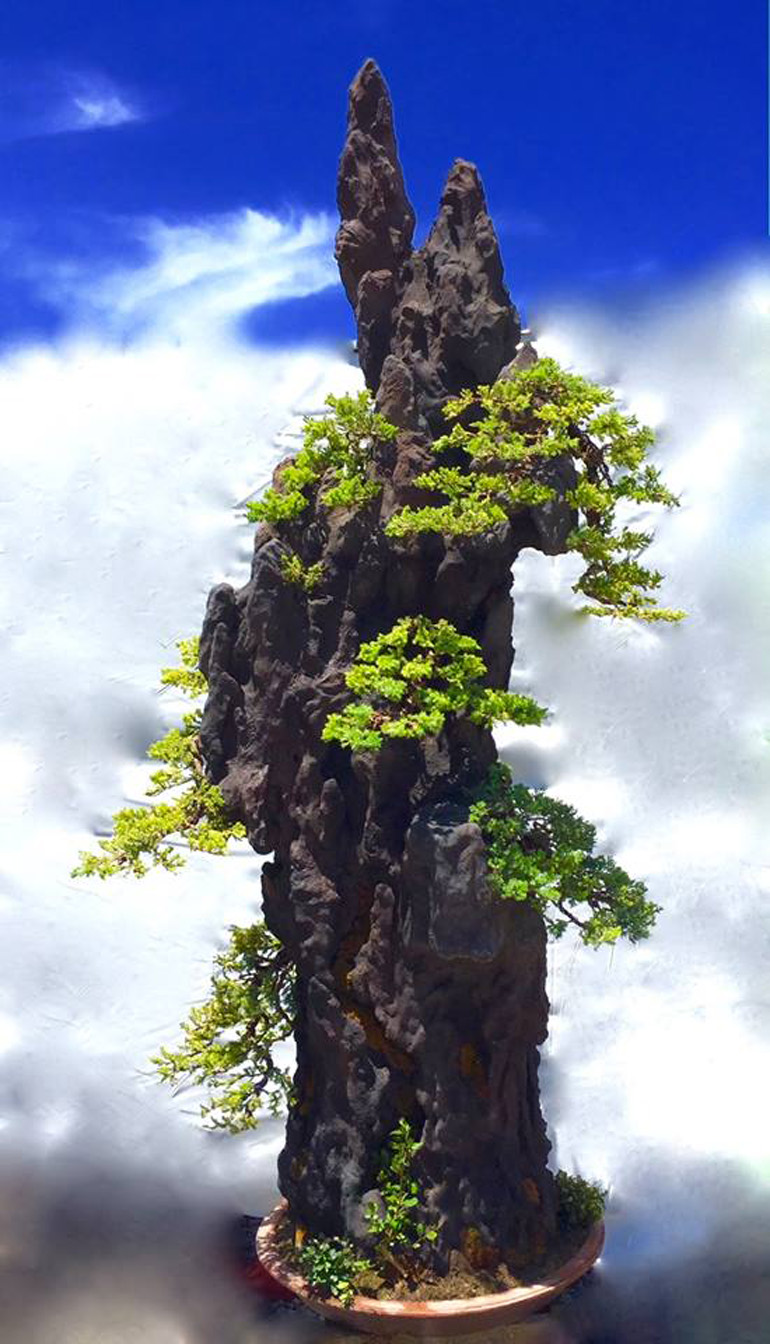
Here's Marc Noelanders' caption for this magnificent rock planting. "We do not only find high buildings in Israel, but also tall rock planting . The sky is the limit . This week Bonsai school in Israel and the rock planting from Sagi we started in December, finally the finish"
I found these photos on Marc Noelander’s timeline. They are also on Sagi Baron’s timeline. All the information we have on this project is in Marc’s quote (in the caption above) and in the photos featured here. It would be good to have more photos and some detailed instruction, but beggars can’t… and I’m delighted to have what we do!
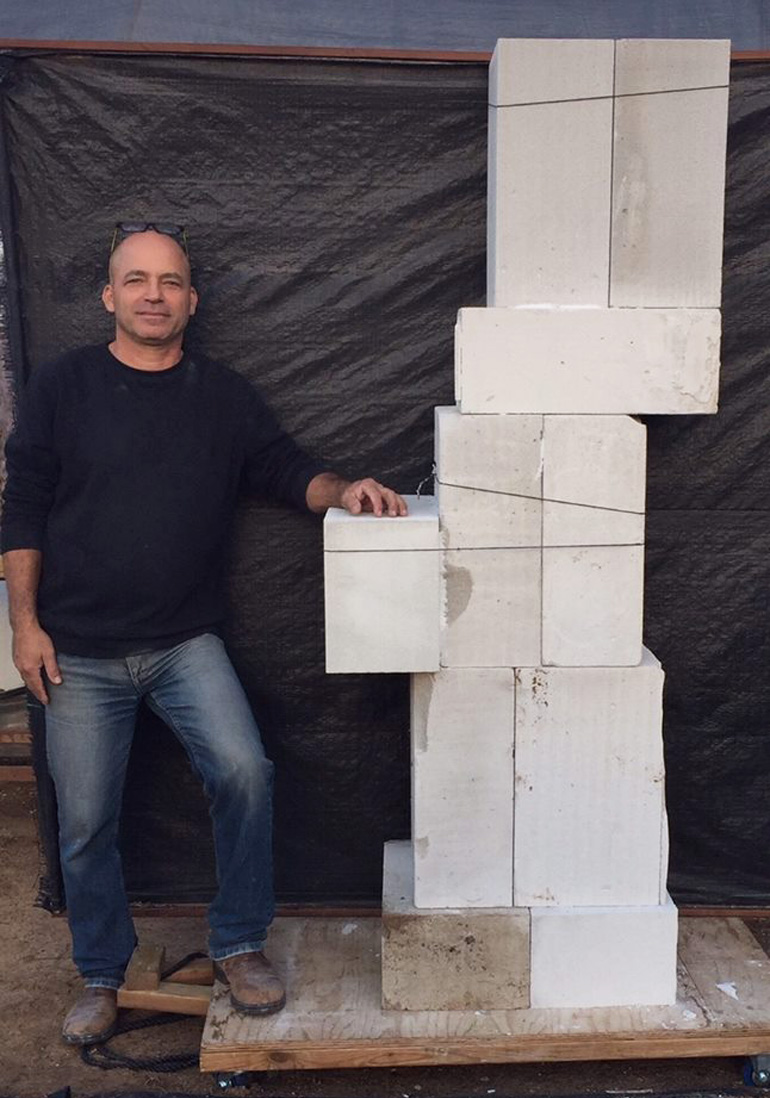
Sagi with the first stage completed
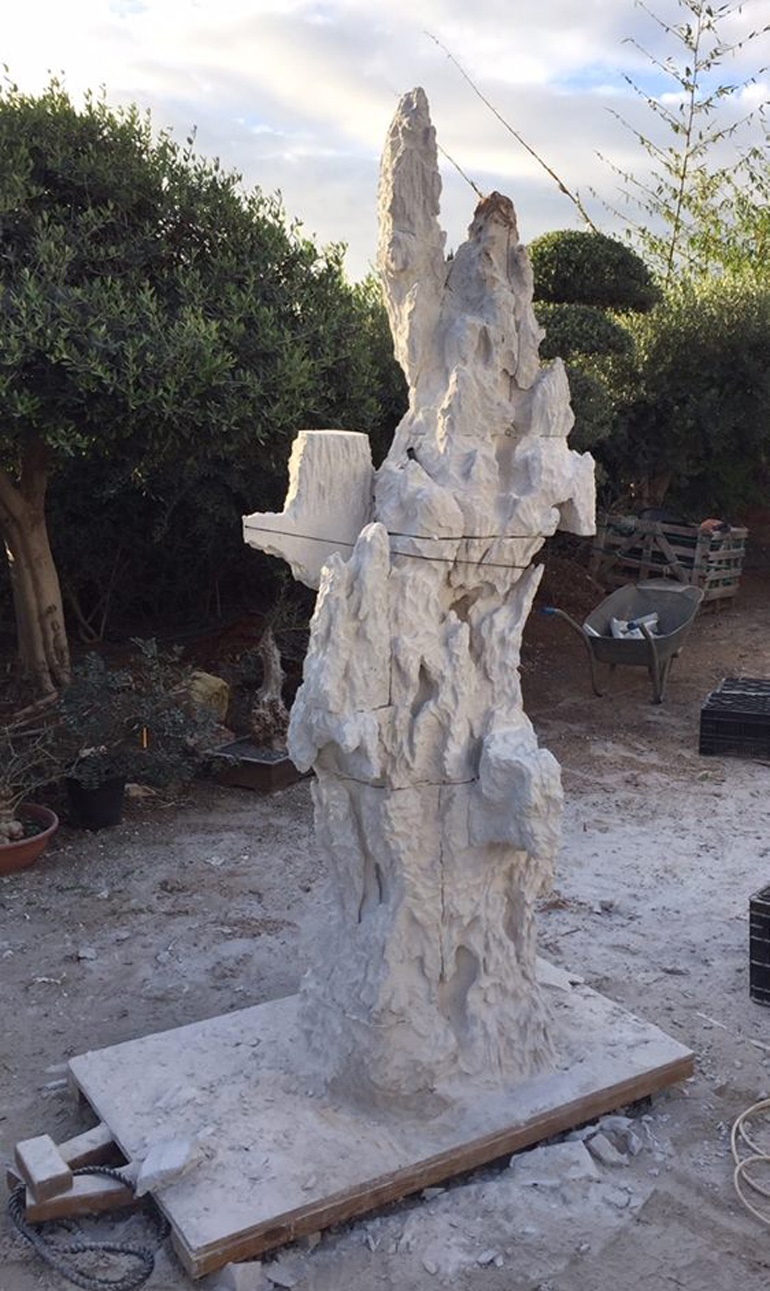
Getting closer

The top. The rock comes out very dark in the original, so I brightened these closeups (this one and the next two). As a result, the plants are washed out some, but you can see the detail in the rock a bit better
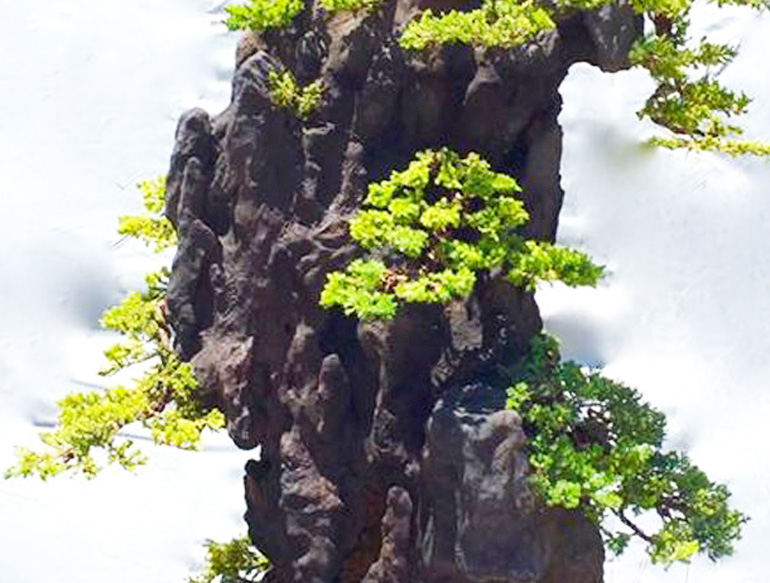
Mid section
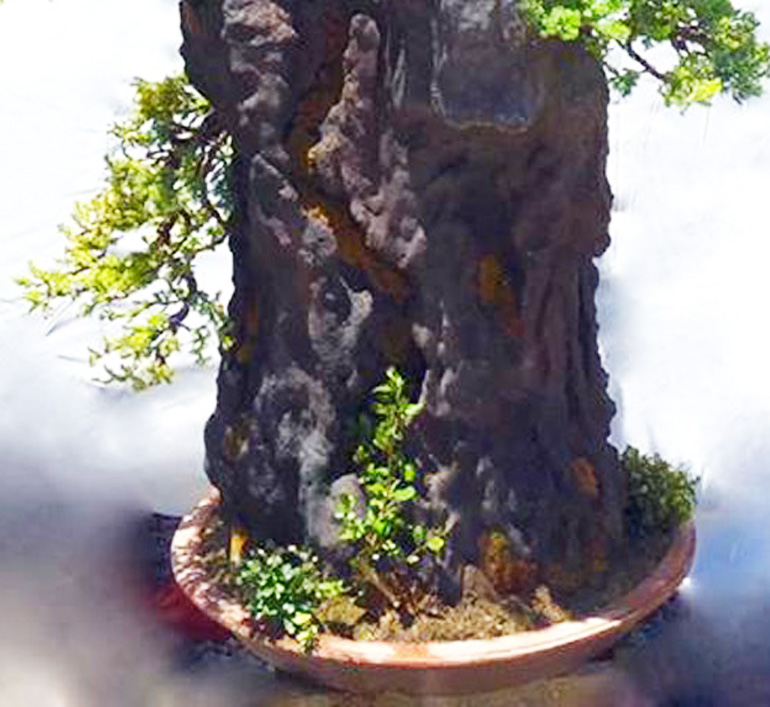
The base and pot

Once again, the whole magnificent creation
No Matter Where You Go
This tall, wild looking Sabina juniper was styled by Walter Pall. The photo is from The Art of Bonsai Project. The pot is by Bryan Albright.
Major computer meltdown here (fortunately not our website, so you can still order and we can still ship), but rather our bookkeeping system where we keep track of inventory, money etc (wish us luck!). So time for another shortcut while sticking with our Sabina juniper theme. This one is from October 2013.
No matter where you go, there’s Walter Pall with some more bonsai from his seemingly endless collection and his tireless offering of valuable instruction, especially on His Bonsai Adventure Blog. Walter is both prolific and very good at what he does. In this case, what he does is style some Sabina junipers, a bonsai species that may be common in Europe, but is little-known here in North America.
This Sabina is from a post on Walter's Bonsai Adventures. The tree was collected in Austria in 1997.
Here’s what Wikipedia has to say about Sabina junipers: “Juniperus sabina (Savin Juniper or Savin) is a species of juniper native to the mountains of central and southern Europe and western and central Asia, from Spain east to eastern Siberia, typically growing at altitudes of 1,000-3,300 m.” This might help explain the ‘little known here in North America” piece.
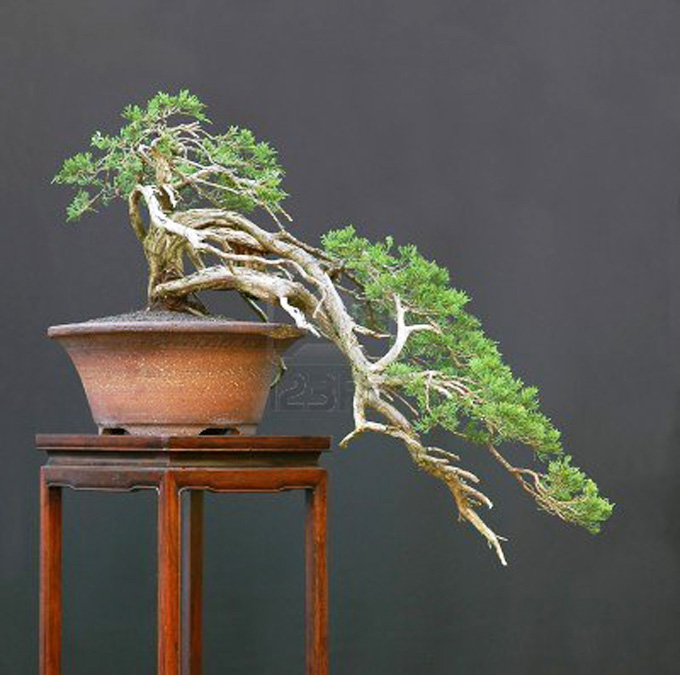 This is a stock photo of a cascading Sabina with a somewhat ‘in training’ look. The caption says, “Sabina juniper, Juniperus sabina, 50 cm high, 80 cm long, 100 years old, collected in Austria, styled by Walter Pall.”
This is a stock photo of a cascading Sabina with a somewhat ‘in training’ look. The caption says, “Sabina juniper, Juniperus sabina, 50 cm high, 80 cm long, 100 years old, collected in Austria, styled by Walter Pall.”
A Happy Bonsai Accident
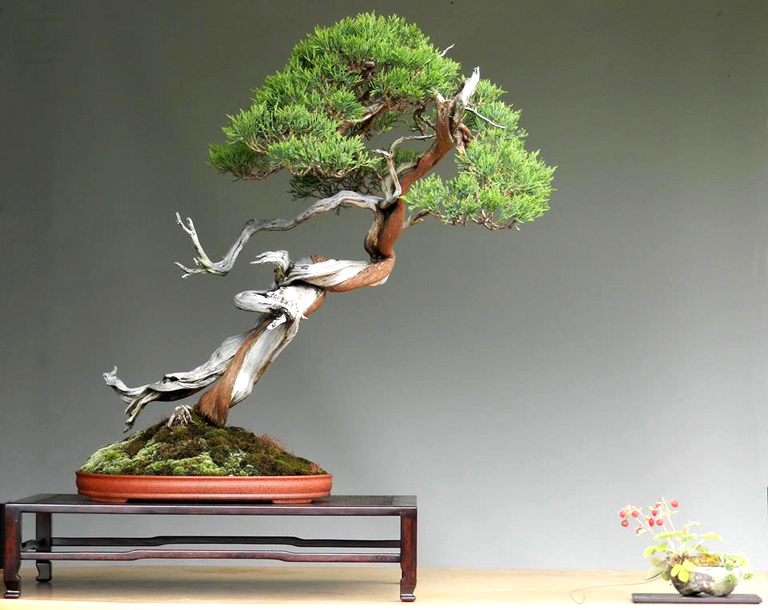
The original caption from Milan Karpíšek reads "Sabina of my friend ready for a show." From this we might assume that the tree belongs to a friend and was styled by Milan, but we know about assumptions.
The three trees shown here are from Milan Karpíšek’s fb photos (Milan is from the Czech Republic). Like many of the bonsai featured here, these were discovered by accident (aka stumbled upon). A very happy accident indeed.
After yesterday’s post featuring two Savin junipers (Juniperus sabina) by Gaicomo Pappalardo, I went back to see others we’ve featured over the years and was surprised by just how many there are. This one is from July, 2014. The post was titled A Happy Accident
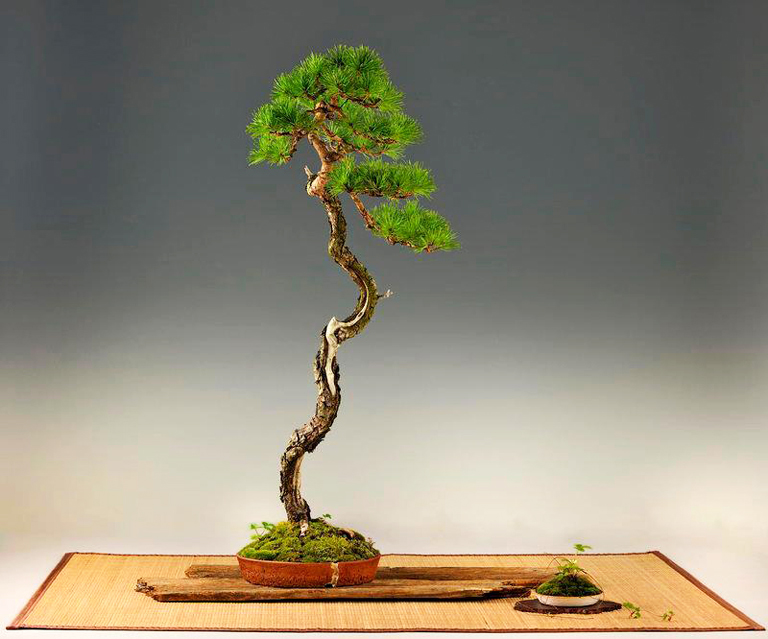
The caption on this lovely literati says "My entry on Noelanders." Milan doesn't say what kind of pine it is (Scot's?). BTW: The Noelanders Trophy is one of Europe's premier bonsai shows.
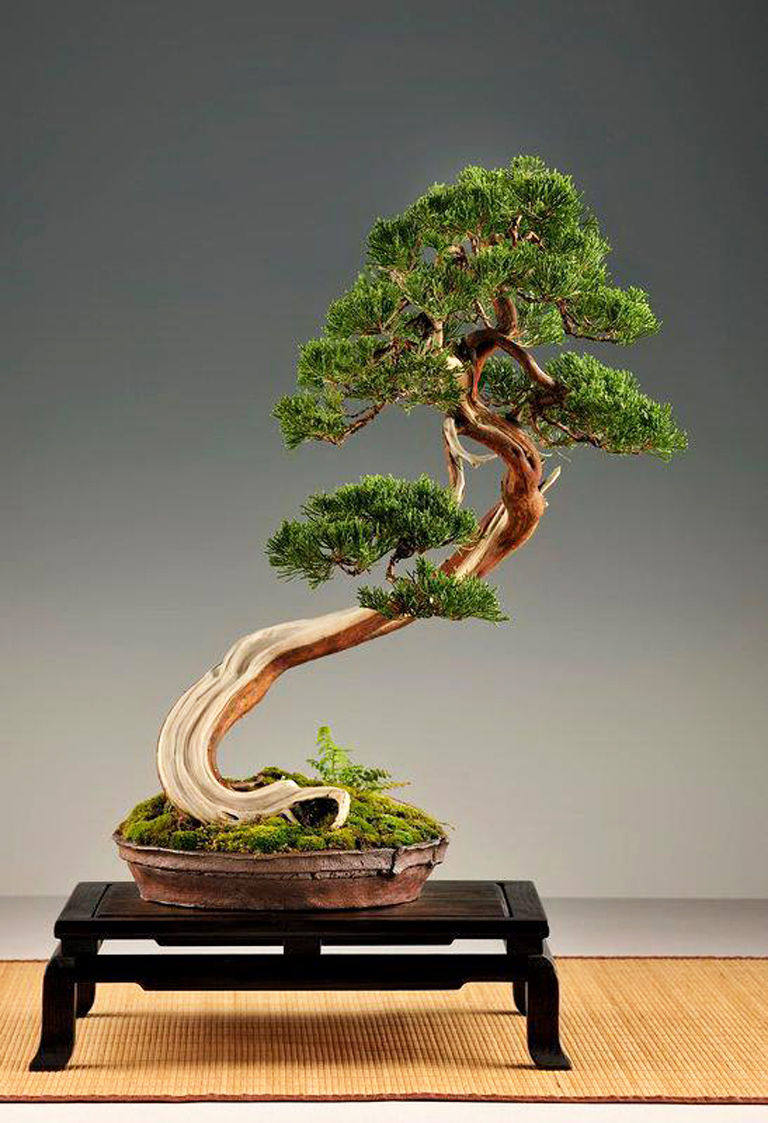
The caption on this one reads "For Sándor Papp the best picture of my Sabina photo Willy Evenepoel, Pilsen 2é11."
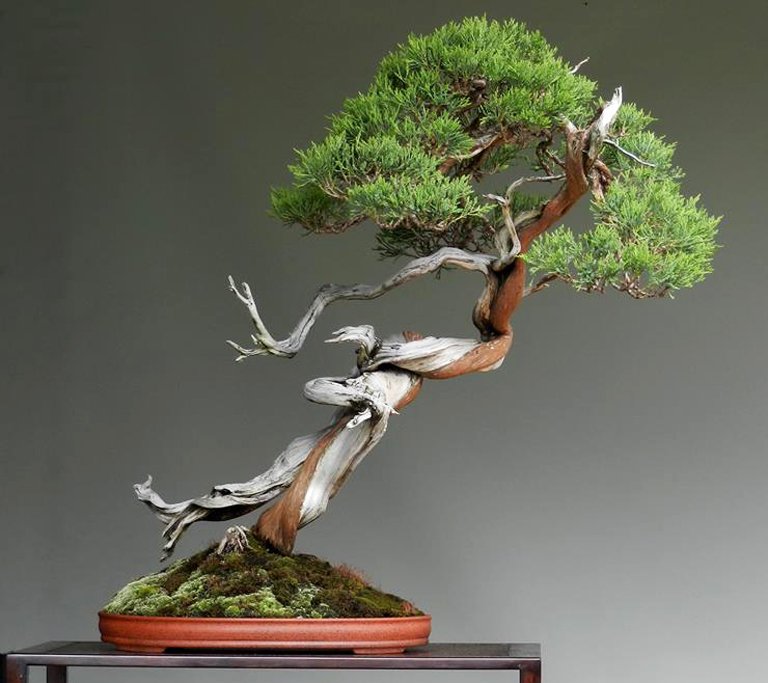
Close up of the tree at the top of the post. One thing that stands out is just how small the pot is relative to the tree. It's the mounding that makes this possible, but even so, that's a lot of tree for a small amount of soil.
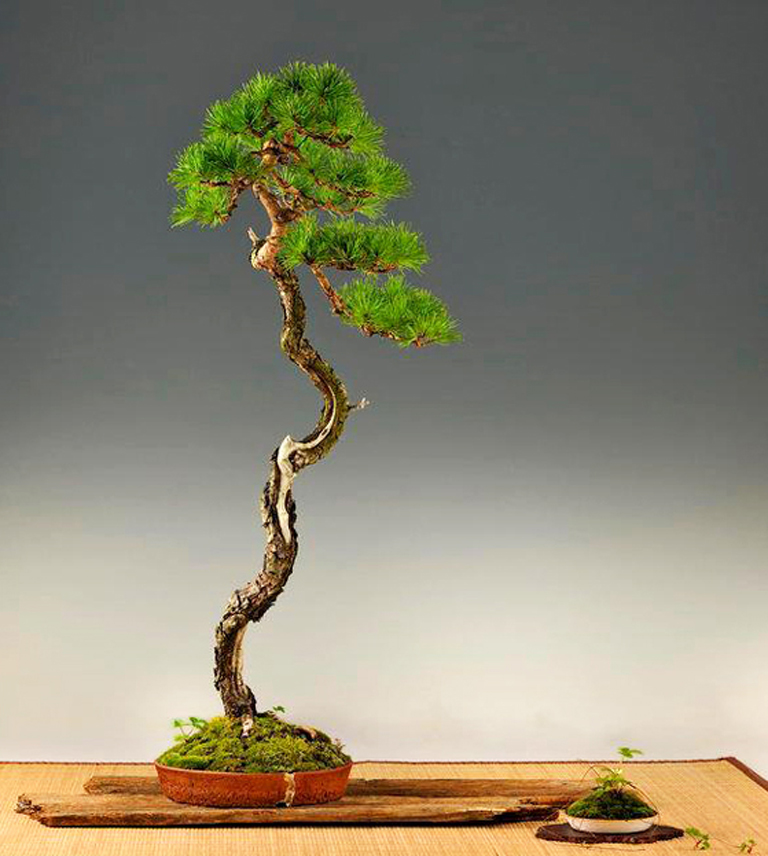
This close up of the elegant second tree provides a better look at the wonderfully aged bark and that chic shari. Nice pot too.
–
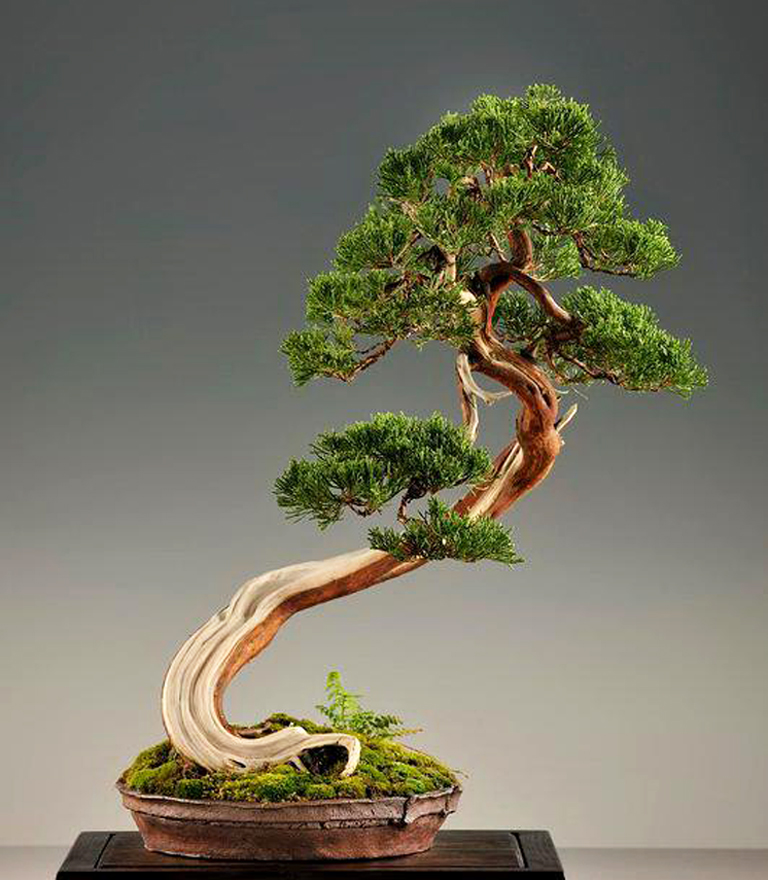
This close up provides a great look at the superb handmade pot and that sweet little fern. Not to take anything away from the tree itself, which needs no superlatives.
Extreme Bonsai
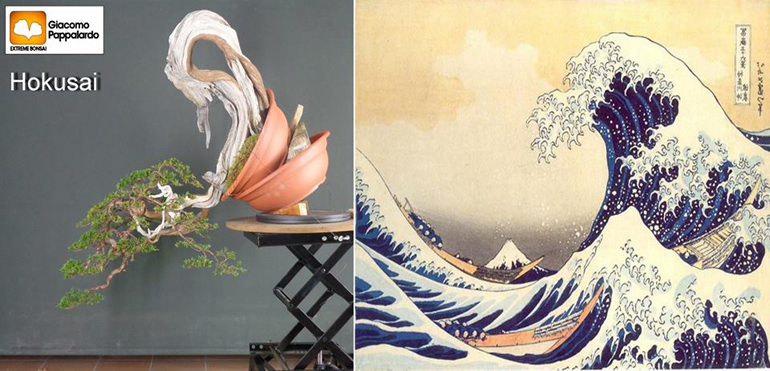
Perfect! The tree is a Savin juniper (Juniperus sabina) and you already know the painting.
Before I realized that Gaicomo Pappalardo’s bonsai nursery is called Extreme Bonsai, I was taken with how unusual many of his trees are. Now it all make sense.
Today we’ve got three of Gaicomo’s Junipers that caught my eye. If you’d like to see more, you might want to visit Extreme Bonsai’s website or facebook timeline. Or in person if you’re ever in A Coruña, Spain.
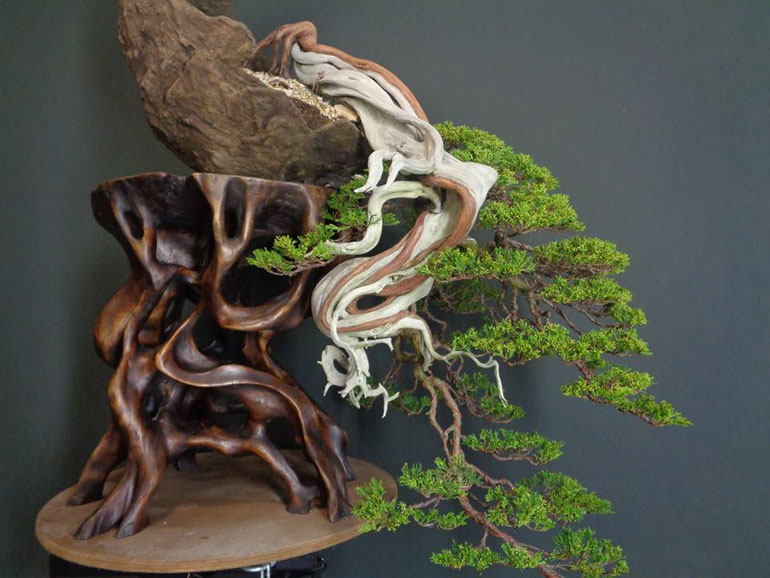
Another wild and wonderful full cascade Juniperus sabina
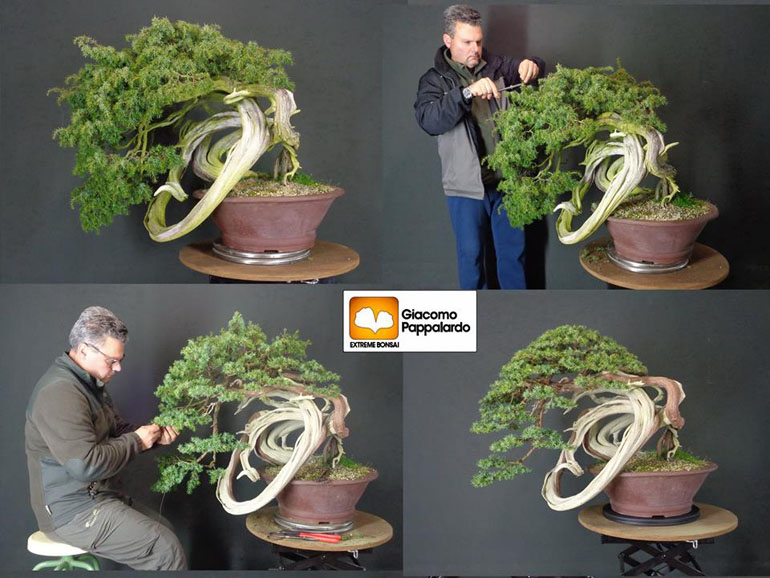
Giacomo calls this series 'Breakfast with donuts' If you look inside the big circle, you'll see a smaller circle. Thus donuts rather than donut? It looks like another juniper, but he doesn't say what type.
Before & After Bonsai – Rediscovering a Juniper’s Natural Beauty

Here's Tyler Sherrod's caption for a job well done.... "Just wired up this juniper for Joe Noga. He has owned this tree for about 30 years. It was grafted with kishu foilage by Mr. Mas Ishii of California. Another cool piece of history of bonsai in America."
Monday morning and we’re already behind, so we’ll let the photos do the talking…. except to say that Tyler Sherrod is one of several Americans (and other Westerners) who has gone through the rigors of a Bonsai apprenticeship in Japan and has brought back his impressive knowledge and skills. Here’s you link to Tyler on fb.
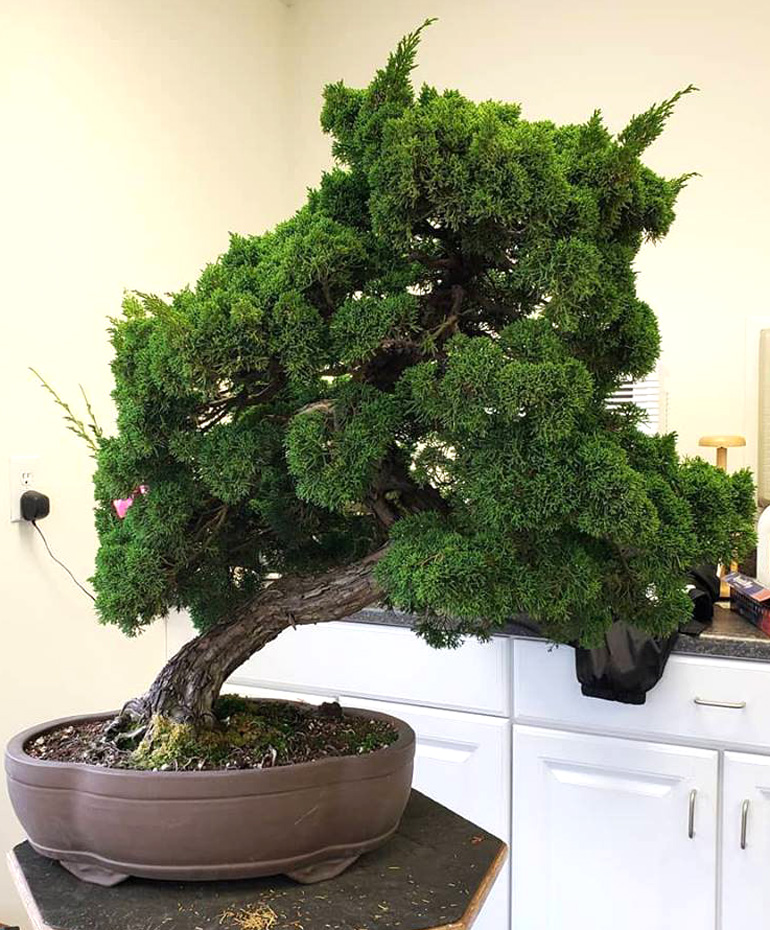
Before. It's always best to start with a healthy robust tree
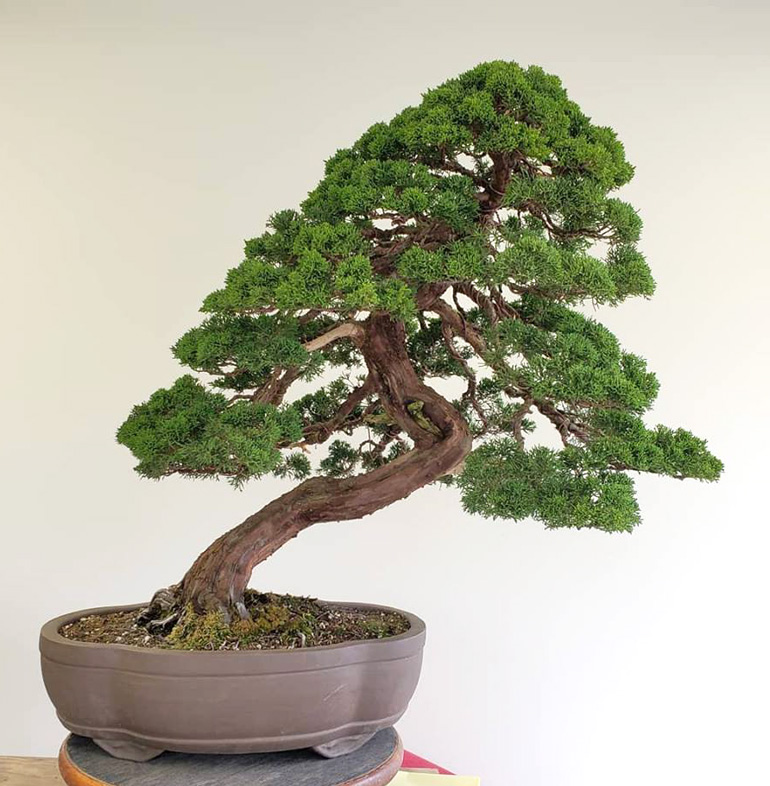
After. An excellent example of what some wire and shears can do in the hands of a skilled bonsai artist
When to Let a Tree Run Off Leash by Michael Hagedorn
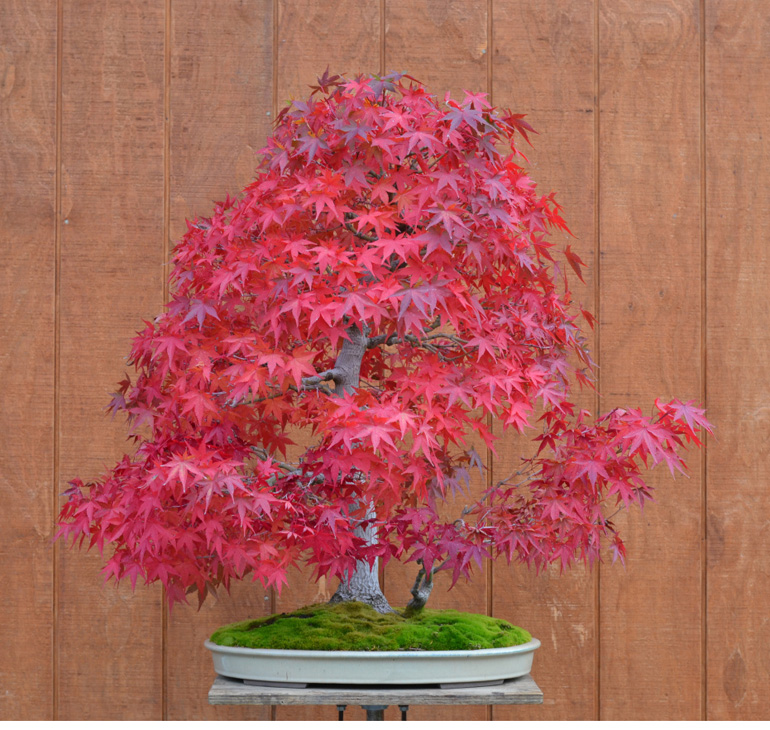
This luminous Japanese maple in full fall color is from Michael Hagedorn's Crataegus Bonsai Portfolio. I don't know for sure when, or for how long Michael lets this one off the leash, but after reading the article below, I have some idea.
Here’s an important topic that we seldom hear about. So even though we just ran this post back in September, I think it’s worth another go.
Once again we’re paying homage to the wisdom of Michael Hagedorn, our favorite source for the nitty-gritty of growing bonsai. This time it’s about managing, and especially not managing, the growth of our trees. Our source for the text is Michael’s Blog. For the photos it’s Michael’s Portfolio
In Michael’s own words…
“We talk endlessly about how to manage the growth of bonsai. Which technique for this species, which for that…and it’s a good thing we do, as it’s very important. If we get it wrong we could end up in a pretty pickle.
“Less often do we talk about how important the opposite is for an old bonsai: Letting the tree go a bit. Stop ‘managing’ it for a while. Many trees cannot be kept in continual show shape.”
Continued below…
NEW BONSAI TOOL SPECIAL
see below
–
"An old Winter Hazel (Corylopsis spicata) in a box for some rejuvenation following a couple years of weakness, now showing long extensions and large leaves"
Michael Hagedorn continued from above…
“There are two concepts here and I don’t wish to confuse them. Most trees need to grow a bit seasonally before they can be cut back to where the profile is. Without that extension growth, if we’re constantly nibbling on the tree, then it can just tire out. This goes for many trees, not all, but it’s not the purpose of this post to go into detail about all that.
“So there’s that idea, seasonal wildness, unrestrained growth. Then there’s the other one, where over some years of life in a bonsai pot, an old bonsai begins to just tire somewhat. It takes a close eye and a good memory to know when is the right time to let a tree off the leash.
Continued below…
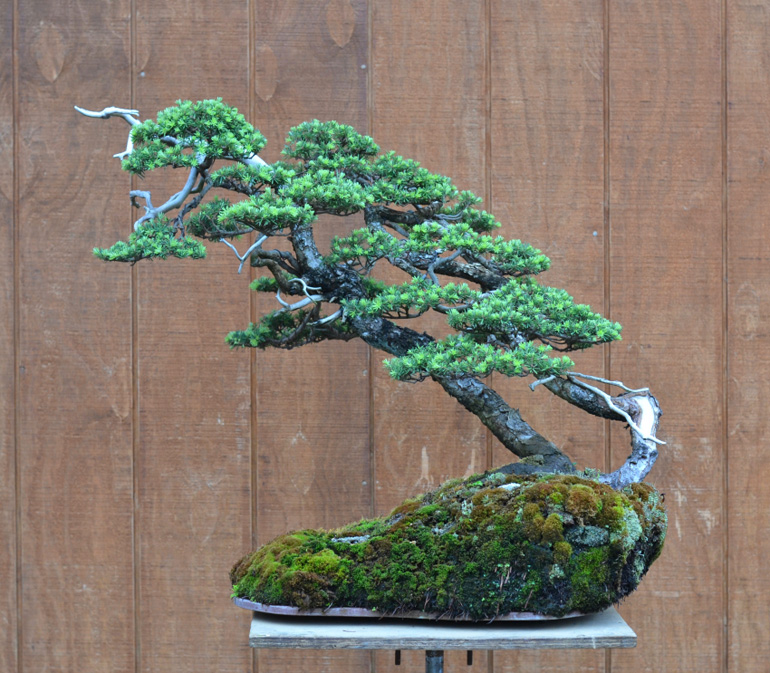
Mountain hemlock (Tsuga mertensiana) on levitated nylon board from Michael's portfolio. We've featured it several time over the years and for good reason (something to do with improving a wild tree without sacrificing it's natural wildness). Yesterday we featured a Mountain hemlock by Michael that was new to us.
Michael continued from above…
“Any of you who have dogs know that when you go to the beach or a big field, and take the leash off, it is amazing to see a totally new animal. It takes off and becomes years younger. It laughs. Dances. Becomes a wolf, even if it doesn’t look like one.
“The same thing happens for bonsai. Sometimes after years of applying the same techniques to contain growth—which is an important idea—the tree slows down to be point of damaging it. Branches begin to tire out. We might lose a few. And then it’s time to consider taking the leash off.
“There are a few ways to do this—simply leaving the tree grow for a while unrestrained, maybe until fall. Or if it seems like a serious problem and you’re losing parts of the tree, slip potting it in a box, with large size soil. Be careful, though, as these techniques can totally change the age of a tree. If left too long in a box, a bonsai soon won’t have the structure of a bonsai any more. Leaving it grow unmanaged for one growing season for a light adjustment, to three years for a really tired old tree, is the range.
Continued below…
Still the best bonsai read…
Post-Dated
The Schooling of an Irreverent Bonsai Monk
If you haven’t already, this is a good time to dig into and enjoy
Michael victories & humiliations as a bonsai apprentice in Japan
Michael continued from above…
“Deciduous trees and conifers can respond significantly differently when let go. The deciduous tree is like a small rowboat, easy to turn in the water, needing only months to a year for an upward physiological swing. Conifers can take longer to turn around, sometimes a couple of years, like a big old battleship that takes miles to turn to port.
“And then after a summer of joyful growth, or maybe after a couple years if it’s a really tired out grandparent of a tree, return it to a bonsai pot.”
Visit Michael Hagedorn on his website and his blog. It’s always a click worth making
NEW SPECIAL
ROSHI BONSAI TOOLS
30% OFF LIST PRICES
